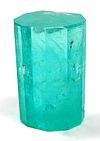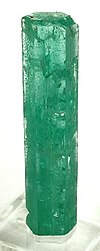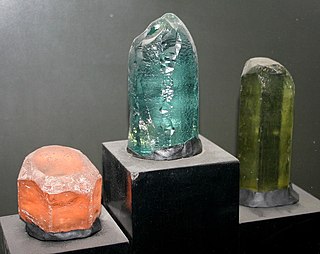
Beryl ( BERR-əl) is a mineral composed of beryllium aluminium silicate with the chemical formula Be3Al2Si6O18. Well-known varieties of beryl include emerald and aquamarine. Naturally occurring hexagonal crystals of beryl can be up to several meters in size, but terminated crystals are relatively rare. Pure beryl is colorless, but it is frequently tinted by impurities; possible colors are green, blue, yellow, pink, and red (the rarest). It is an ore source of beryllium.
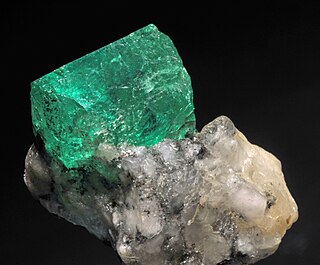
Emerald is a gemstone and a variety of the mineral beryl (Be3Al2(SiO3)6) colored green by trace amounts of chromium or sometimes vanadium. Beryl has a hardness of 7.5–8 on the Mohs scale. Most emeralds have much material trapped inside during the gem's formation, so their toughness (resistance to breakage) is classified as generally poor. Emerald is a cyclosilicate.

Muzo is a town and municipality in the Western Boyacá Province, part of the department of Boyacá, Colombia. It is widely known as the world capital of emeralds for the mines containing the world's highest quality gems of this type. Muzo is situated at a distance of 178 kilometres (111 mi) from the departmental capital Tunja and 118 kilometres (73 mi) from the capital of the Western Boyacá Province, Chiquinquirá. The urban centre is at an altitude of 815 metres (2,674 ft) above sea level. Muzo borders Otanche and San Pablo de Borbur in the north, Maripí and Coper in the east, Quípama in the west and the department of Cundinamarca in the south.

The Gachalá Emerald, one of the most valuable and famous emeralds in the world, was found in 1967, in the mine called Vega de San Juan, located in Gachala, a town in Colombia, located 142 km (88 mi) from Bogota. Gachalá Chibcha means "place of Gacha." Presently the emerald is in the United States, where it was donated to the Smithsonian Institution by the New York City jeweler, Harry Winston.

Trapiche emerald is a rare variety of the gemstone emerald, characterized by a six-arm radial pattern of usually black spokes separating areas of green emerald. If weathered, the black spokes may become light in color. Trapiche emerald is one of an assortment of trapiche or trapiche-type minerals. Others include trapiche ruby, sapphire, tourmaline, quartz, and chiastolite. The name comes from the Spanish term trapiche, a sugar mill, because of the resemblance of the pattern to the spokes of a grinding wheel. Emerald is a gem variety of the mineral beryl, and owes it distinctive green color to the presence of chromium and/or vanadium.
Gilberto Molina Moreno was a major Colombian emerald magnate who was intimately connected to the notorious Medellín cartel and widely suspected of involvement in drug trafficking during the 1980s.

Maripí is a town and municipality in the Colombian Department of Boyacá, part of the subregion of the Western Boyacá Province. The town hosts an important emerald mine; La Pita.
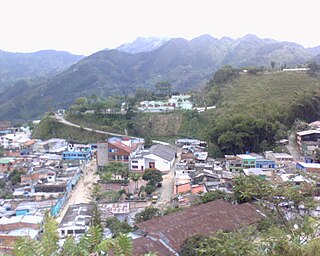
Quípama is a town and municipality in the Colombian Department of Boyacá, part of the subregion of the Western Boyacá Province.

Chivor is a town and municipality in the Eastern Boyacá Province, part of the Colombian department of Boyacá. The mean temperature of the village in the Tenza Valley is 18 °C (64 °F) and Chivor is located at 215 kilometres (134 mi) from the department capital Tunja. Economic activity includes emerald mining.

Somondoco is a town and municipality in the Colombian Department of Boyacá. This town and larger municipal area are located in the Valle de Tenza. The Valle de Tenza is the ancient route connecting the Altiplano Cundiboyacense and the Llanos. The area is dotted with many such little towns all located at approximately the same altitude. Somondoco borders Almeida in the east, Guayatá in the west, Guateque and Sutatenza in the north and in the south the Cundinamarca municipality of Ubalá.
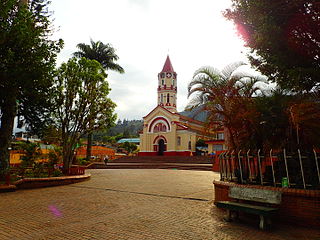
Gachalá is a municipality and town of Colombia in the Guavio Province, part of the department of Cundinamarca. The urban centre of Gachalá is situated at a distance of 148 kilometres (92 mi) from the capital Bogotá at an altitude of 1,712 metres (5,617 ft) in the Eastern Ranges of the Colombian Andes. The municipality borders the western portion of the split municipality Ubalá and the department of Boyacá in the north, the eastern part of Ubalá and Medina in the east, Fómeque, Junín and Gama in the west and Fómeque, Medina and the department of Meta in the south.

Mineral industry of Colombia refers to the extraction of valuable minerals or other geological materials in Colombia. Colombia is well-endowed with minerals and energy resources. It has the largest coal reserves in Latin America, and is second to Brazil in hydroelectric potential. Estimates of petroleum reserves in 1995 were 3.1 billion barrels (490,000,000 m3). Colombia also possesses significant amounts of nickel and gold. Other important metals included platinum and silver, which were extracted in much smaller quantities. Colombia also produces copper, small amounts of iron ore, and bauxite. Nonmetallic mined minerals include salt, limestone, sulfur, gypsum, dolomite, barite, feldspar, clay, magnetite, mica, talcum, and marble. Colombia also produces most of the world's emeralds. Despite the variety of minerals available for exploitation, Colombia still had to import substances such as iron, copper, and aluminum to meet its industrial needs.

The Muzo people were a Cariban-speaking indigenous group who inhabited the western slopes of the eastern Colombian Andes. They were a highly war-like tribe who frequently clashed with their neighbouring indigenous groups, especially the Muisca.
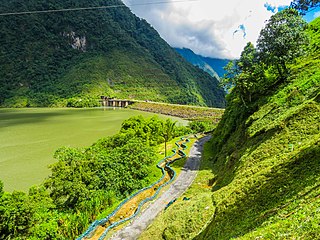
The Tenza Valley is an intermontane valley in the Eastern Ranges of the Colombian Andes. The valley stretches over the southeastern part of the department of Boyacá and the northeastern part of Cundinamarca. It is located east of the Altiplano Cundiboyacense and in the time before the Spanish conquest of the Muisca, as the Altiplano was inhabited by the Muisca in the higher altitudes and the Tegua in the lower areas to the east.
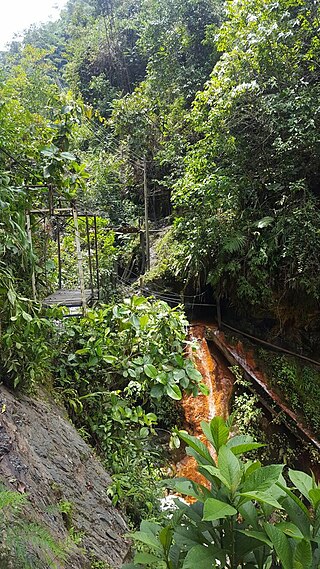
The Las Pavas, also called La Pava, is a Colombian emerald mining area that is neighboring Colombia's largest emerald mine, Puerto Arturo. It is located 200 kilometres (120 mi) northwest of the capital Bogotá in the western emerald belt of Muzo, and about 235 kilometres (146 mi) west of Chivor, which is in the eastern emerald belt. The mining area spans the municipalities Quípama and Muzo.
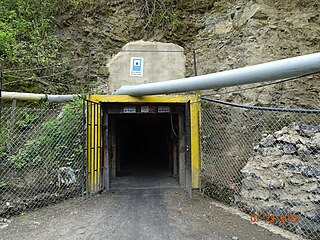
La Pita is an emerald mine located in the western belt of the Colombian emerald mining area. It is owned and operated by the Colombian company, Zuliana De Esmeraldas Ltda.
Furatena Airport is an airport serving the emerald region of the western emerald belt and town of Quípama in the Boyacá Department of Colombia. The airport is four nautical miles west of Muzo Airport.
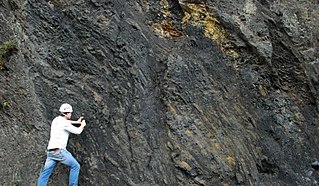
The Macanal Formation or Macanal Shale is a fossiliferous geological formation of the Altiplano Cundiboyacense and Tenza Valley in the Eastern Ranges of the Colombian Andes. The predominantly organic shale formation dates to the Early Cretaceous period; Berriasian to Valanginian epochs and has a maximum thickness of 2,935 metres (9,629 ft). The Macanal Formation contains numerous levels of fossiliferous abundances. Bivalves, ammonites and fossil flora have been found in the formation.


























